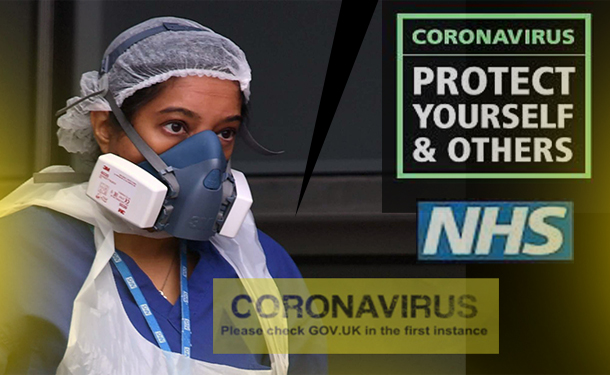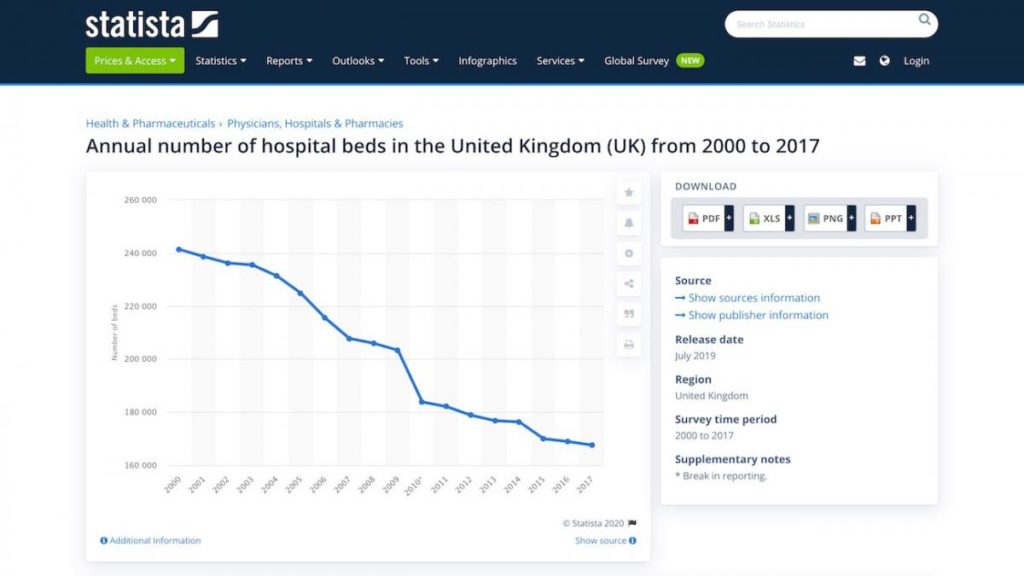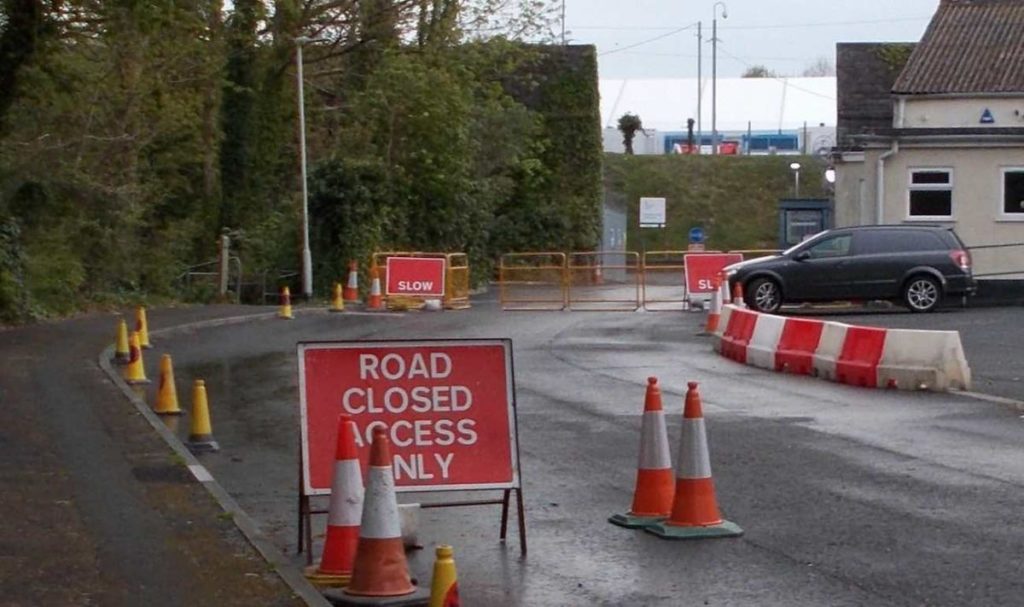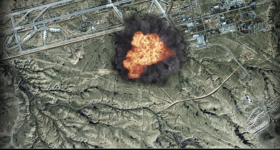
Robin Kayser
UK Column
It’s April 2020, and since March, the UK has swiftly commissioned and built vast, temporary, intensive care hospitals, in readiness for a predicted epidemic number of severe COVID-19 cases.
They are called NHS Nightingale Hospitals, and to date there are seven of them, either open or planned. The first one was announced on 24 March by the Health Secretary, Matt Hancock, and was opened almost immediately on 3 April at the London Excel Centre. It has a capacity of some 4,000 beds. The other temporary field hospital sites are in Manchester, Birmingham, Glasgow, Bristol, Exeter, Harrogate, and Washington.
Additionally, over the last month, some 8,000 beds in private hospitals have been re-assigned for Covid-19 use, along with other NHS beds in hospitals all over the UK. By the beginning of April, one third of all non-ICU NHS beds had been converted into potential ICU beds for possible Covid-19 patients. Yet, by 12 April, the London Nightingale had treated just 19 patients, and to date, only 41 patients have been treated.
This sudden blitz is both unusual and unprecedented. We regularly have seasonal infectious illnesses spread throughout the population; in fact in recent years, some of these epidemic diseases were also predicted well in advance. Yet no new mega-hospitals, temporary or otherwise, were ever built to cope with them, nor were they seen to be needed. Why now?
According to the King’s Fund, over the last thirty years, the number of ICU beds has declined, at a time when the population has risen. Over that period, around 34% of general and critical care beds in England have been lost.
Peter Donaghy, an independent data analyst, reports that the UK now comes near the bottom of the world league in the number of hospital beds per head of population: in 2019, and across the four UK nations, he found that there are about 5.7 ICU beds per 100,000 of the population [interpolation of his figures mine]. Cyprus has double that number, Germany has 29, the USA 34, and even Kazakhstan and Mongolia do better than the UK.
Bed shortages are not news, however. In 2008, it was revealed that 32,000 beds of all types had been cut in the decade since 1997, when, ironically, the Blair government came into power on a ticket of increasing the number of hospital beds.
Between 2010 and 2017 there were 70,000 fewer intensive care beds in the UK:

In 2016, the Royal College of Surgeons had complained of chronic bed shortages, so much so that the occupancy rates had gone beyond 89%, when 85% is considered the maximum safe level. This complaint was made just before the British Medical Association chimed in, reporting on the shortage of beds being more severe than in other Western countries, and that such overcrowding can lead to the spread of infections.
And in 2018, the Faculty of Intensive Care Medicine (FICM) astonishingly reported that across the UK, 80% of intensive care units were sending patients to other hospitals, either because of a lack of beds or a shortage of staff, particularly nurses.
To cap things off, by 2019, it was being reported by the British Medical Association that ICU beds had begun to be used for patients recovering from routine operations, and that when more emergency beds were needed, a policy of “escalation beds” came into force. The BMA drily reported that there was “little sign of this practice ending”.
When one thinks of the NHS, intensive care is at the heart of most people’s perceptions of it. Yet the decline in the number of ICU beds over the last 30 years is so counterintuitive that it’s as if some monster deus ex machina has intervened and decided not only that the general numbers of hospital beds are of little import, but that intensive care beds are even more expendable. But whatever the case, in the event of a mass epidemic, the consequences of ICU bed shortages were indeed grim prior to 2020.
What official policies have the post-Blair governments been maintaining throughout this decline in the number of ICU beds?
To get a general feel, looking back to 2011, the government published the UK Influenza Pandemic Preparedness Strategy Paper, outlining what the official response to a hypothetical pandemic should be.
This paper appears to have been written largely in response to the 2009 H1N1 influenza outbreak. Its precautionary approach stresses that actions following the emergence of a pandemic, which could occur suddenly at any time:
- must be evidence based
- be proportional to the level of threat
- be flexible
- be based on ethical principles.
- emergency powers must last no longer than 30 days
Significantly, it states that during any pandemic, it should be “business as usual” and notes that its recommendations are in line with an earlier, 2007, National Framework paper’s “defence in depth” approach to a pandemic.
The Pandemic Preparedness Strategy Paper also makes clear that military personnel are not to be redeployed during a pandemic, but must remain on their normal defence duties. So of course, this means that they were not to be used to help build vast temporary hospitals, transport patients, or manage the public.

Military convoy off the coast at Devonport on the morning of 23 March, the day Boris Johnson announced the lockdown.
In fact, the paper is silent on any hospital bed policies; it takes it as read that there would be enough UK ICU beds for the treatment of pandemic disease patients – for in 2009’s H1N1 swine flu outbreak, generally, hospitals may have just coped with finding enough beds for acute H1N1 patients. There were 540,000 cases of swine flu in England, and 138 fatalities at the time, or 0.026% of those infected.
Exercise Cygnus
Following the publication of the 2011 preparedness paper, however, the number of ICU beds continued to fall. Then, five years later, government held an unusual and secretive event called Exercise Cygnus.
It involved all government departments, all local authorities, and the NHS, right across the UK. Its report has not been published for “national security reasons” and so as not to “frighten the public”. However, according to those with first-hand knowledge of the operation, Cygnus’ script contained a scenario of a patent lack of capacity in ICU beds and personal protective equipment.
Based on its given hypotheses, it predicted that thousands more critical care beds would be required, large parts of the NHS would need to be switched off to redeploy staff, frail patients would be denied care, and mortuaries would be overwhelmed.
Was this just an experiment to see how the public sector actors involved would react to each other, like some kind of Grand Guignol? Did the exercise take its inspiration from the memorably twisted 2012 London Olympics ceremony, in which rows of thousands of NHS patients in hospital beds, in a dark auditorium looking like a Nightingale Hospital, were danced around by strange beasts and actors wearing scrubs?
The modelling of Cygnus was done by Imperial College, London, under the aegis of Neil Ferguson, who is also now doing the modelling of Covid-19.
Tellingly, it is said that last month’s Coronavirus Act, the emergency legislation which underpins the lockdown, is based on his modelling in Exercise Cygnus. Ferguson’s involvement in the Coronavirus crisis does raise other questions – for further coverage see Vanessa Beeley’s article: Who controls the British Government response to Covid–19?
Outside of the strange artificial world of Exercise Cygnus, the British Medical Association and the Royal College of Surgeons continued to complain about bed shortages. So why was there no turnaround policy introduced at least by 2016 after these professional outcries?
The Health Secretary at the time was Jeremy Hunt. Simon Stevens was Chief of NHS England. Both had been involved in cutting bed numbers. Yet, since 2016, and prior to the COVID-19 outbreak, with Sir Simon Stevens still at the helm, there appears to have been no general improvement in ICU bed capacity.
Following Exercise Cygnus, in 2017, the NHS Board published a short internal paper called Emergency Preparedness, Resilience and Response (EPRR). Its approach is centred on three Acts of Parliament: the Civil Contingencies Act (2004), the NHS Act (2006), and the Health and Social Care Act (2012).
Drawn up by Director of Operations and Information for the NHS Board, Matthew Swindells (sic), it asks the Board to agree that progress had been made in EPRR over the last year, and that the NHS was in a state of pandemic readiness. EPRR was rubber stamped, but as we have seen above, the somewhat rosy, self-congratulatory picture that was approved by the NHS Board was shown to be completely incorrect by Statista in 2017, and later, by the Faculty of Intensive Care in 2018, the BMA in 2019, and Peter Donaghy in 2020.
Back to Exercise Cygnus. This was supposed to be merely a computer simulation. So why would it be an issue of “national security”? Why would it “frighten the public”? Perhaps because it was intended to change the real world into its simulated image?
It’s an uncanny coincidence that, after the Coronavirus pandemic was declared, it was announced that there were not enough ICU beds or personal protective equipment, that NHS staff have been redeployed to other areas, that hospitalised elderly patients have been denied care through the use of “Do Not Resuscitate” orders, and large, temporary, mortuaries have also been built up and down the country, just as in the simulation.

Temporary mortuary set up in Ernesettle Fort, Plymouth.
Since the first reported UK Covid-19 case, there has been non-stop media coverage propagandising the numbers of cases and deaths, and its threat. All the while, there have been regular reports that many ICU beds are empty, that beds of other sorts are empty, and that although accident and emergency visits are down, people with serious conditions telephoning the NHS advice and triage number, are being told to “Stay at home – Save the NHS – Save Lives”. Many of these callers have then died for lack of care.
It has also emerged that standards in death registration have been lowered by the government, and that there has been encouragement to register anyone who dies, of any underlying condition, as a Covid-19 death. There need be no objective verification of the existence of Covid-19 to register a death as being caused by it.
Despite these efforts to inflate the death rate, actual mortality rates since the beginning of this crisis do not show that we are in the middle of a pandemic, and actual critical case numbers are not overwhelming the NHS’s depleted intensive care units. In that regard, Covid-19 is not mirroring Exercise Cygnus’ computer-generated scenario.
The government response, however, seems to match it exactly.
***
READ MORE CORONAVIRUS NEWS AT: 21st Century Wire Coronavirus Files
SUPPORT OUR INDEPENDENT MEDIA PLATFORM – BECOME A MEMBER @21WIRE.TV














